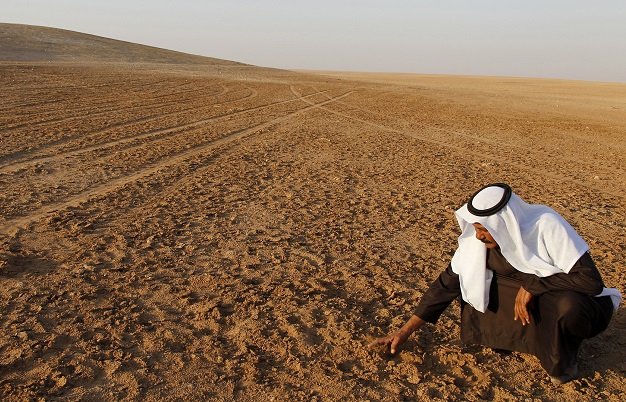
Source: The New Internationalist
Last year, the media started joining the dots between the crisis in Syria and climate change. But they only got half the story right. They badly misrepresented the role of social movements in Syria; and they painted Syrian migrants as a source of violence and chaos. Most reporting ignored the complex relationship between climate, drought, migration and conflict. Research by the Climate and Migration Coalition reveals a disconnect between what the media claimed and what actually happened.
The case I’m making here is not that climate change was irrelevant to the start of the conflict in Syria. In fact, there is strong evidence that a powerful climate-driven drought played an important role.
In 2015, research emerged linking Syria’s drought to rapid and massive internal migration. The drought badly affected Syria’s agriculture, which in turn destroyed livelihoods and forced rural Syrians to seek work in cities. This is a common pattern across the world, but it usually happens peacefully. This rural-to-urban movement often becomes a key survival strategy for millions of people.
Yet many media outlets got the next part of the story completely wrong. They claimed that the increased population in Syria’s cities led to some kind of resource war; that Syrians turned on each other; and that competition over scarce food and housing led to violence. Many media outlets suggested that violence erupted along religious or ethnic lines. (See these news stories mapped.) They claimed that these initial conflicts then descended into a full-scale civil war.
The suggestion was that migration led to scarcity and then eventually to violence. The reality, however, is different. It is true that a severe climate-fuelled drought hit Syria in the years before the 2011 uprising. It’s also true that this drought drove many rural Syrians into nearby cities. But this is where the media narrative departs from reality.
For many years, rural Syrians had faced several stark difficulties. The severe drought was one. But catastrophic state-level mismanagement of Syria’s agriculture was also a huge problem. Anger against the regime had grown steadily over the years.
Omar Imady outlines how microfinance co-operatives provided much-needed security for many Syrian farmers. The co-operative started in the 1990s and spread across Syria, providing loans and insurance to small-scale farmers. The co-ops were owned by their members and their leaders were democratically elected. But they were not purely financial; they brought rural Syrians together and provided a platform for political organizing. Representatives from the early co-operatives travelled across Syria helping other groups get started.
The idea of independent, co-operatively owned, democratic organizations troubled the Syrian regime. That these co-ops became a way for ordinary Syrians to organize politically worried the regime even more. The fact they were spreading became intolerable.
In 2008, the Syrian government started dismantling the co-operatives.
Rural Syrians had enjoyed a brief period of political organizing. As the co-ops were taken apart, this was suddenly stripped from them. At the same time, the drought grew more severe. Millions of rural Syrians found themselves facing extreme poverty and hunger. The co-operatives had provided some financial security for Syrian farmers; without this, many found themselves even more vulnerable to drought.
Uprisings began in rural areas in 2011. As these initial demonstrations took off, many carried their protests into Syrian cities, where they got global media attention. Rural Syrians moving into cities to find work joined with thousands of urban residents, who shared their anger, in demanding an end to the regime. This combination fuelled the early stages of the uprising. This was not a resource war, but an act of co-operation.
Reinoud Leenders argues that the regime had been going to great lengths to segregate Syrian society, and that the movement of people from rural to urban areas disrupted this separation.
The uprising did not succeed in overthrowing the regime, but neither did the regime manage to crush the uprising. In this period of instability, many other armed groups entered the conflict and Syria rapidly descended into a full-scale civil war.
As the violence escalated, millions of Syrians fled. Many news outlets asked whether people crossing the Mediterranean were the first climate refugees. But the Syrians seeking refuge in Europe are fleeing conflict, not the direct impacts of climate change.
The patterns of migration are usually different when people move due to climate impacts. For example, when drought or typhoon strike, people tend to move the shortest distance possible, usually not crossing international borders, and then often return to take part in the reconstruction of their homes. Where entire countries are threatened by rising waters, as in the Pacific, people often move in advance, on legal working visas. Many are already taking part in organized relocations with the help of their governments.
Climate change on its own is not likely to create cross-border migration. The tragedy unfolding in the Mediterranean is not an inevitable part of life on a hotter planet. Problems arise when patterns of climate-driven migration collide with existing violence.
The media coverage did ordinary Syrians and all migrants a terrible disservice. It painted them as a source of violence and chaos within their own country and across Europe. Yet Syria’s politically organized migrants actually took part in a bold act of co-operation and took an incredible risk in pursuit of democracy and human rights.
Alex Randall works for the Climate and Migration Coalition. The coalition supports and protects people at risk of displacement linked to disasters and climate-change impacts.
